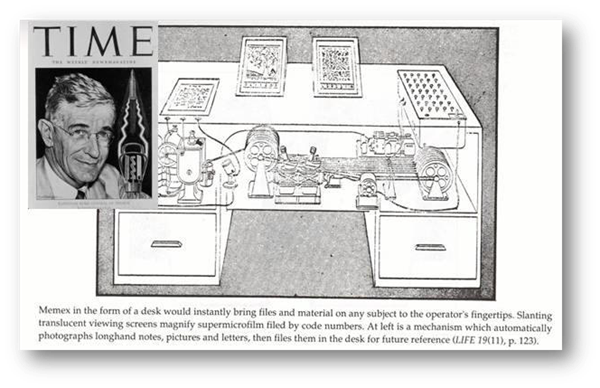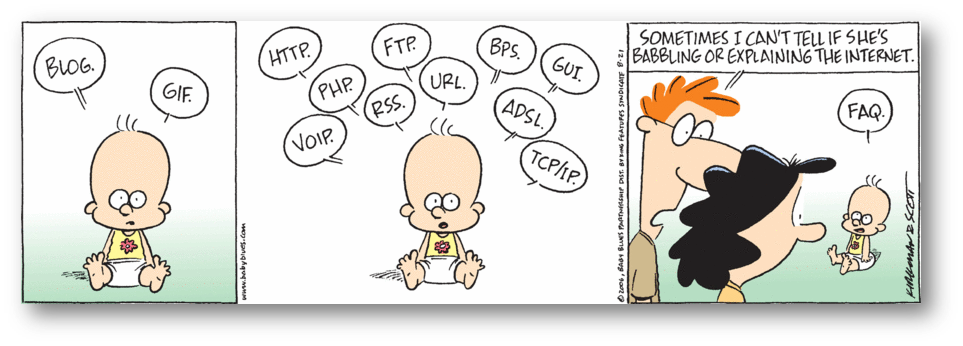
Tools for Information Literacy
The Internet - a network of networks
Where did it all come from?
A network of networks with no one, and everyone, in charge.
But with a structure that everyone uses.
A bit of background - Foreseeing the future: The legacy of Vannevar Bush, by Erin Malone, Boxes & Arrows, 16 Jun 2002

intro ARPANET conceptual evolution WorldWideWeb control domains
back to top
The beginnings: ARPANET
In 1958, the U.S. government formed the Advanced Research Projects Agency (ARPA) within the Defense Department and gave it a mission to ensure U.S. leadership in science and technology with military applications. Over time, ARPA evolved into the Defense Advanced Research Projects Agency (DARPA). In 1969, ARPA established ARPANET, the forerunner of the Internet.
ARPANET was a network that connected major computers at the University of California at Los Angeles, the University of California at Santa Barbara, Stanford Research Institute, and the University of Utah. Within a couple of years, several other educational and research institutions joined the network.
ARPANET was designed to allow continued communication if one or more sites were down. At its heart, ARPANET, and the Internet that evolved out of it, were designed as reliable communications tools.
ARPANET history (if you want more) by Michael Hauben at Columbia
intro ARPANET conceptual evolution WorldWideWeb control domains
back to top
Conceptual

- How the Internet Works, Rus Shuler @ Pomeroy IT Solutions
- How IP Addresses Work, howstuffworks.com
- How Protocols Work, howstuffworks.com
- Domain Growth on the Internet, Verisign
intro ARPANET conceptual evolution WorldWideWeb control domains
back to top
Evolution
Throughout the 1970s, developers created the protocols used to transfer information over the Internet. By the early 1980s, Usenet newsgroups and electronic mail had been born. Most users were affiliated with universities, although libraries began to connect their catalogs to the Internet, too. During the late 1980s, developers created indices, such as Archie and the Wide Area Information Server (WAIS), to keep track of the information on the Internet. To give users a friendly, easy-to-use interface to work with, the University of Minnesota created its Gopher, a simple menu system for accessing files, in 1991.
intro ARPANET conceptual evolution WorldWideWeb control domains
back to top
The Web
The World Wide Web came into being in 1991, thanks to developer Tim Berners-Lee and others at the European Laboratory for Particle Physics, also known as Conseil Europeenne pour la Recherche Nucleaire (CERN). The CERN team created the protocol based on hypertext that makes it possible to connect content on the Web with hyperlinks. Berners-Lee now directs the World Wide Web Consortium (W3C), a group of industry and university representatives that oversees the standards of Web technology.
Early on, the Internet was limited to noncommercial uses because its backbone was provided largely by the National Science Foundation, the National Aeronautics and Space Administration, and the U.S. Department of Energy, and funding came from the government. But as independent networks began to spring up, users could access commercial Web sites without using the government-funded network. By the end of 1992, the first commercial online service provider, Delphi, offered full Internet access to its subscribers, and several other providers followed.
In June 1993, the Web boasted just 130 sites. By a year later, the number had risen to nearly 3,000. Five years later, there were more than 2.2 million sites on the Web. And it just keeps growing ...
Industry experts now predict that the number of Internet-connected devices will exceed 15 billion nodes by 2015 and top 50 billion by 2020.
Not quite, but the guess is that there were 46 billion by 2021.
intro ARPANET conceptual evolution WorldWideWeb control domains
back to top
Who's in control here?

No one authority controls the World Wide Web. Today's web site authoring tools allow virtually anyone who has access to a computer and the Internet to post a Web site and contribute to the definition of what this medium is and what it can do. But the World Wide Web Consortium does oversee the development of Web technology.
You shape the Web
According to Tim Berners-Lee,
The dream behind the Web is of a common information space in which we communicate by sharing information. Its universality is essential: the fact that a hypertext link can point to anything, be it personal, local, or global, be it draft or highly polished.
With the development of tools that allow us to create Web sites without having any knowledge of hypertext markup language (HTML), this dream is being realized. When we create our own web sites in this course, we will be one of the forces shaping this "common information space".
Keeping an eye on the standards of Web technology is W3C, formed by Berners-Lee in 1994. An international group of industry and university representatives, W3C promotes the Web by developing common protocols for transmitting information over the Internet. The consortium provides information, reference code, and prototype and sample applications to developers and users. It is hosted by the Massachusetts Institute of Technology's Laboratory for Computer Science in the United States, the Institut National de Recherche en Informatique et en Automatique in Europe, and the Keio University Shonan Fujisawa Campus in Japan.
intro ARPANET conceptual evolution WorldWideWeb control domains
back to top
What are domains and how do domain name servers work?
Domains divide World Wide Web sites into categories based on the nature of their owner, and they form part of a site's address, or uniform resource locator (URL).
ICANN (Internet Corporation for Assigned Names and Numbers) has overall responsibility for managing the Domain Name System. It controls the root domain, delegating control over each top-level domain to a domain name registry.
Originally there were only a few common top-level domains (TLD), but that has changed. The IANA lists numerous variations. Each country linked to the Web has a two-letter top-level domain. For example, .de is Germany, .fr is France, .ie is Ireland, and .tv is Tuvalu.
Existing Generic TLDs
- .com ⇒ companies, now broader
- .edu ⇒ educational institutions
- .gov ⇒ government institutions
- .int ⇒ international organisations, e.g. Interpol
- .mil ⇒ military organisations
- .net ⇒ networking technologies, now broader
- .org ⇒ non-profit organisations
- .arpa ⇒ first ever domain, now technical use
- .aero ⇒ air travel industry
- .biz ⇒ business alternative to .com
- .coop ⇒ co-operatives
- .info ⇒ information, but open for general use
- .museum ⇒ museums
- .name ⇒ personal names - johnsmith.name
- .pro ⇒ professionals, e.g. doctors
- .asia⇒ Asian websites
- .cat ⇒ Catalan language
- .jobs ⇒ employment websites
- .mobi ⇒ mobile phones
- .post ⇒ postal services
- .tel ⇒ telecoms
- .travel ⇒ travel
Many state and local governments use the country domain system
- Rockingham County Schools uses the country plus K12 domain system.
- Moore County government used to use the co.[name].nc.us naming system, but has changed to .gov.
- Alamance County government, too, is different.
- California used to use both .gov and .us, while Monterey County sticks with the .us system
- North Carolina uses both .gov and .us, but the state.nc.us domain maps to the .gov domain.
intro ARPANET conceptual evolution WorldWideWeb control domains